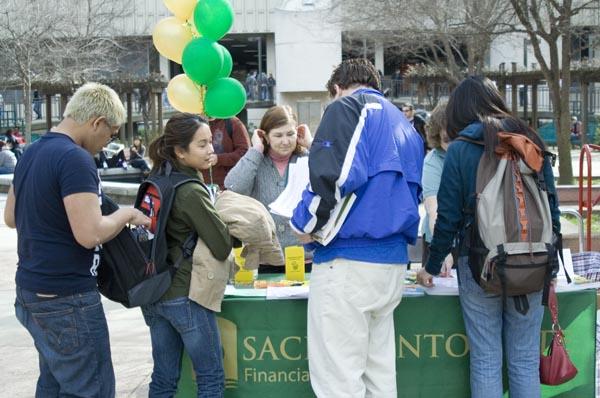Financial aid fair, FAFSA deadline nears

Mechanical engineering major Kim Sanguenza, sophomore pre-nursing major Precious Galang and two other students receive information about financial aid at a table on the Library Quad.:
February 19, 2008
As the deadline to submit financial aid documents approaches, the month of February is aimed at providing awareness to the Sacramento State community about financial aid and activities designed to further students’ better understanding of the application process.
Craig Yamamoto, director for Financial Aid at Sac State, said there will be two financial aid workshops offered Feb. 23 and 28.
Yamamoto said students having trouble completing their Free Application for Federal Student Aid (FAFSA) forms should attend the workshops for assistance. The workshops will not only provide students with the opportunity to fill out their applications with unlimited resources at their assistance, but they will offer prizes and other options for aid, he said.
The deadline for FAFSA applications to be completed and submitted by is March 3. If students don’t submit their applications by the deadline, the applications will still be accepted.
Financial aid awards are given based on need. The sooner a student turns in a FAFSA application, the more likely he or she will receive aid, Yamamoto said.
“There are two deadlines, one for the Cal Grant program and one is for priority deadline. Students can still apply after the deadline, but some is based on need and then on a first-come, first-serve basis,” Yamamoto said.
Students who have not completed a FAFSA application are unable to receive subsidized or unsubsidized student loans, according to Financial Aid’s official website.
While the workshops were designed to help students understand the financial aid process better, many students said they are already familiar with the financial aid application and award process.
Junior economics major Jason Angle receives grants and loans. He said the process to obtain these is simple.
“The process can be difficult when you first apply, but after that, you just have to renew it every year, which is not too bad,” Angle said.
Angle said students who are struggling should budget their money better to avoid financial conflicts.
Other students, like junior pre-graphic design major Candi Mayfield, said they made too much money to be considered eligible for government-awarded financial aid.
“I’ve reduced my hours (at work) and that change didn’t help me get more aid,” Mayfield said. “Unless I make well below the poverty line, I don’t qualify. It penalizes a hardworking person who wants to attend school and still work, but needs a little help.”
Senior journalism major Grecia Garcia also found that if she worked in college, FAFSA would not cover her tuition.
“Financial aid covers tuition, but my parents supplement the rest. But it’s very stressful to rely on family, especially when a family has more than one kid in college,” Garcia said.
Garcia ran for Sac State’s track and field and cross country team for the 2006-07 season, but found the financial and time commitment were too much to handle.
With the increase of college tuition, many students found that most loans are barely enough to cover tuition, much less the various expenses many have. Yamamoto encouraged students to seek other options if they are unsatisfied with the amount they are allowed to take out in loans.
“The maximum amount awarded isn’t always enough to cover expenses, but we don’t drive the process,” Yamamoto said. “The amounts are set by the state and federal governments. If I were a student, I’d work with ASI to see what they could do to lobby for lower fees and more financial aid.”
Aside from government grants and awards, schools offer unsubsidized and subsidized student loans through various banks and institutions. The amount a student is eligible to receive through loans is contingent on what year in school they are currently in, according to Financial Aid’s official Web site.
Because students find it hard to work and juggle a full school schedule, some will turn to private loans, like Astrive and Sally Mae.
Yamamoto does not feel that private loans are a good idea for students. He said he believes students can receive what they need through federal loans. However, unless the federal loans increase, some students said they will not receive all the help they need to cover their college expenses.
Senior government journalism major Kristina Schuett said many people will eventually choose not to apply to a four-year university due to tuition increases.
“I know, personally, if I stayed any longer, I couldn’t afford to keep going to school. It would definitely discourage me,” Schuett said.
Yamamoto disagreed with the assertion that rising tuition would make higher education impossible for students to pursue. For students with the lowest income, financial aid will always be beneficial, he said.
“What rising tuition does is force middle-class students to take out more loans than they want,” Yamamoto said. “But loans are a part of financial aid. Lots of parents and students don’t think loans are a part of the package.”
The interest rate on student loans through the school is fixed at 6.8 percent. Students have 10 years to repay the loan after graduation.
Aside from loans, students who don’t qualify for grants or federal aid have the opportunity to apply for scholarships.
The university offers institutional scholarships and information on community and department scholarships through the financial aid Web site and scholarship office.
Yamamoto encourages students to visit the financial aid workshops to not only complete their applications, but also to enter to win prizes.
“We will raffle off two iPods at each workshop. After a student completes an application, we will have them fill out an evaluation and draw from those for the winner,” he said.
For more information, visit the Financial Aid office located in Lassen 1001.
Amanda Pollard can be reached at [email protected].




























































































































